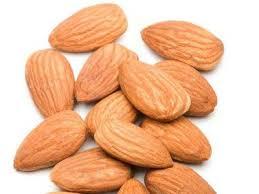Snacking on whole almonds lowers LDL-C, improves endothelial function





Consumption of whole almonds as snacks not only reduces low-density lipoprotein cholesterol (LDL-C) but also significantly improves endothelial function in adults with above-average risk of cardiovascular disease (CVD), according to the results of a trial.
“[R]eplacing typical snacks with almonds can have a meaningful impact on daily nutrient intakes and can improve endothelial function, cardiac autonomic function, and lower LDL-C,” the researchers said. “However, isoenergetic snack substitution in this trial did not modify regional fat deposition, and therefore markers of insulin sensitivity were unaffected.”
This randomized controlled, parallel-arm trial was conducted for 6 weeks. Participants consumed either whole roasted almonds (n=51) or control snacks (n=56), providing 20 percent of daily estimated energy requirements, following a 2-week run-in period consuming control snacks (mini muffins).
The researchers then evaluated endothelial function (flow-mediated dilation), liver fat (magnetic resonance imaging/magnetic resonance spectroscopy), and secondary outcomes as markers of cardiometabolic disease risk at baseline and endpoint.
Compared with control snacks, almonds consumption led to increased endothelium-dependent vasodilation (mean difference, 4.1 percent, 95 percent confidence interval [CI], 2.2–5.9). However, no between-group differences were observed in liver fat. [Am J Clin Nutr 2020;111:1178-1189]
Almonds also decreased plasma LDL-C concentrations compared to control (mean difference, –0.25 mmol/L, 95 percent CI, –0.45 to –0.04), but no between-group differences were seen in triglycerides, high-density lipoprotein cholesterol, glucose, insulin, insulin resistance, leptin, adiponectin, resistin, liver function enzymes, fetuin-A, body composition, pancreatic fat, intramyocellular lipids, faecal short-chain fatty acids, blood pressure, or 24-hour heart rate variability.
On the other hand, almond consumption increased the long-phase heart variability parameter, very-low-frequency power during night-time relative to control (mean difference, 337 ms2, 95 percent CI, 12–661), indicating greater parasympathetic regulation.
“The degree of improvement in endothelial function and LDL-C concentrations suggests that incorporating almonds in the diet in place of typically consumed snacks has the potential to reduce CVD risk by ≤30 percent and therefore could play a powerful role in enhancing cardiovascular health,” the researchers said.
Previous studies have shown that whole almonds reduce postprandial glycaemia and lipemia compared with almond products with a high lipid bioaccessibility where lipid has been mechanically released from the plant cell walls. This can offset acute increases in oxidative stress and inflammation postprandially, according to the researchers. [J Nutr 2006;136:2987-2992; Am J Clin Nutr 2008;88:922-929; Glob Cardiol Sci Pract 2014;2014:291-308; Circulation 2002;106:1327-1332]
In addition, almonds are rich in cardioprotective chemicals, such as L-arginine (which is needed in the process of nitric oxide synthesis), phenolic compounds, vitamin E, and folate. [Glob Cardiol Sci Pract 2014;2014:291-308]
“Whereas concentrations of intracellular L-arginine already exceed that required for nitric oxide synthesis, the increased intake of (poly)phenolics, vitamin E, and folate could reduce oxidative stress and inflammation, thus potentially improving nitric oxide bioavailability,” the researchers noted. [Glob Cardiol Sci Pract 2014;2014:291-308; J Agric Food Chem 2006;54:5027-5033; Molecules 2019;24:366; Am J Clin Nutr 2013;98:1179-1191; Nutrients 2015;7:1728-1743; Nutr Rev 2017;75:61-70]